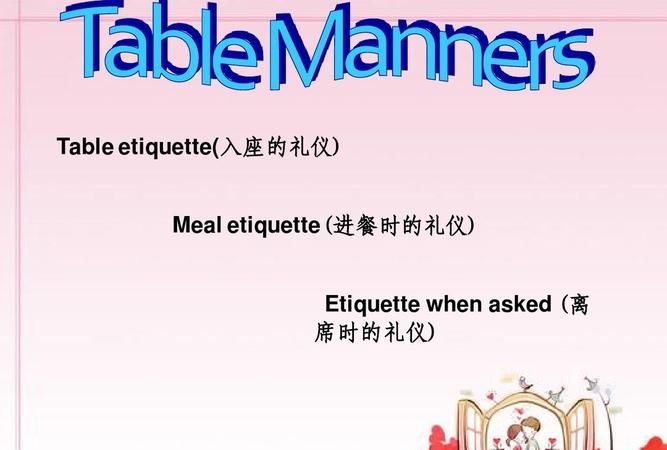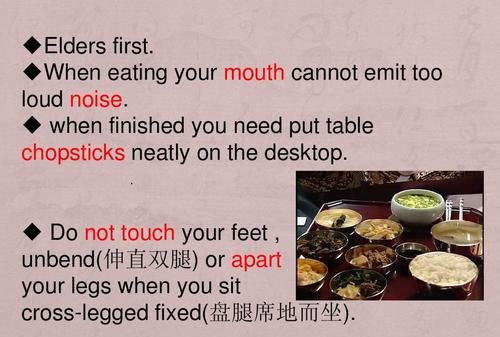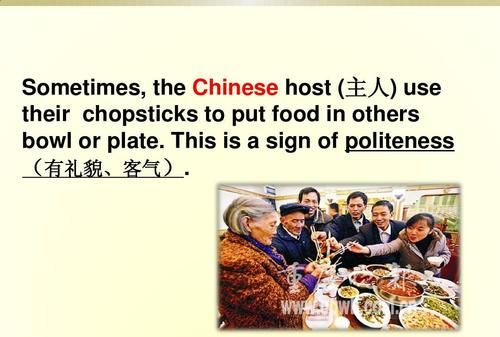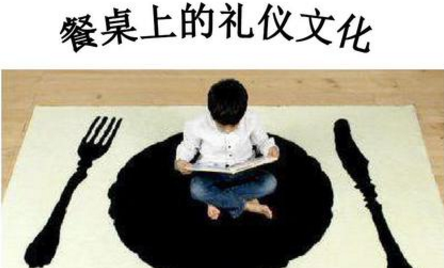本文目录
餐桌礼仪英语作文
Chinese table manners of families have no intrinsic quality even there are different region and position. No matter three meals a day or guest’s arrival, always bowls with chopsticks, food with soup. There is no rule for how to put the tableware. What people care about more are not the gorgeous tableware but the sumptuous food. People’s dining position reflects the most obvious etiquette of Chinese table manners. In ancient society, men are supreme, and women are not allowed to sit with men on the same table. Although this is modern society, this kind of ancient etiquette still remains. Today in China, the phenomenon that men sit on the table before women can be found everywhere. The master of a family usually sits on the first-class seat. The first-class seat is usually near the interior of a room facing to the door. Once there is a guest, the master will offer the first-class seat to the guest politely. If it is an ordinary meal of family, families should start after the elder. If there is a guest, the master offer the food to the guest is essential from the beginning to the end. And the tradition of urging others to drink is also a special phenomenon.
中国就餐举止 家庭中国就餐举止没有内在质量甚而那里是另外区域并且安置。 问题三饭食每天或客人的到来,总不滚保龄球与筷子,食物用汤。 没有规则为了怎样能投入碗筷。 什么人关心关于更多是没有华美的碗筷,而是奢侈食物。 人的用餐的位置反射中国就餐举止最明显的礼节。 在古老社会,人是至尊,并且妇女不允许坐与人在同一张桌。 虽然这是现代社会,这种古老礼节仍然依然存在。 今天在中国,人坐桌的现象,在妇女可以找到到处之前。 家庭的大师通常坐头等位子。 头等位子通常在面对对门的屋子的内部附近。 一旦有客人,大师为客人将礼貌地提供头等位子。 如果它是家庭一顿普通的膳食,家庭应该在长辈以后开始。 如果有客人,主要提议食物对客人对末端从开始是根本的。 并且敦促其他的传统喝也是一种特别现象。

现在我来告诉你一些中国的餐桌礼仪英语
China Dining Custom
Table Manners
The main difference between Chinese and western eating habits is that unlike the West, where everyone has their own plate of food, in China the dishes are placed on the table and everybody shares. If you are being treated by a Chinese host, be prepared for a ton of food. Chinese are very proud of their culture of cuisine and will do their best to show their hospitality.
And sometimes the Chinese host use their chopsticks to put food in your bowl or plate. This is a sign of politeness. The appropriate thing to do would be to eat the whatever-it-is and say how yummy it is. If you feel uncomfortable with this, you can just say a polite thank you and leave the food there.
Eating No-no's
Don't stick your chopsticks upright in the rice bowl.Instead,lay them on your dish. The reason for this is that when somebody dies,the shrine to them contains a bowl of sand or rice with two sticks of incense stuck upright in it. So if you stick your chopsticks in the rice bowl, it looks like this shrine and is equivalent to wishing death upon a person at the table!
Make sure the spout of the teapot is not facing anyone. It is impolite to set the teapot down where the spout is facing towards somebody. The spout should always be directed to where nobody is sitting, usually just outward from the table.
Don't tap on your bowl with your chopsticks.Beggars tap on their bowls, so this is not polite.Also, when the food is coming too slow in a restarant, people will tap their bowls. If you are in someone's home,it is like insulting the cook.
Drinking
Gan Bei! (Cheers! “Gan Bei” literally means “dry [the] glass”) Besides beer, the official Chinese alcoholic beverage is Bai Jiu,high-proof Chinese liquor made from assorted grains. There are varying degrees of Bai Jiu. The Beijing favorite is called Er Guo Tou, which is a whopping 56% alcohol. More expensive are Maotai and Wuliangye.
-
-
- -
--------------------------------------------------------------------------
Of course, the main difference on the Chinese dinner table is chopsticks instead of knife and fork, but that’s only superficial. Besides, in decent restaurants, you can always ask for a pair of knife and fork, if you find the chopsticks not helpful enough. The real difference is that in the West, you have your own plate of food, while in China the dishes are placed on the table and everyone shares. If you are being treated to a formal dinner and particularly if the host thinks you’re in the country for the first time, he will do the best to give you a taste of many different types of dishes.
The meal usually begins with a set of at least four cold dishes, to be followed by the main courses of hot meat and vegetable dishes. Soup then will be served (unless in Guangdong style restaurants) to be followed by staple food ranging from rice, noodles to dumplings. If you wish to have your rice to go with other dishes, you should say so in good time, for most of the Chinese choose to have the staple food at last or have none of them at all.
Perhaps one of the things that surprises a Western visitor most is that some of the Chinese hosts like to put food into the plates of their guests. In formal dinners, there are always “public” chopsticks and spoons for this purpose, but some hosts may use their own chopsticks. This is a sign of genuine friendship and politeness. It is always polite to eat the food. If you do not eat it, just leave the food in the plate.
People in China tend to over-order food, for they will find it embarrassing if all the food is consumed. When you have had enough, just say so. Or you will always overeat!

中国餐桌礼仪英文10条简短
Chinese table etiquette boils down to the following points:
1. Admission etiquette. Ask guests seated on the seats. Please elderly guests in attendance were seated next to attendance at from the left side into the chair. Admission Dongkuaizi not after. What more do not come to beep. Not to get up walk. If what happened to the owner notice.
Second, when the meal. Ask guests. Long the Dongkuaizi. Jiacai, each less. Far from the food on their own eat some. Meal not a voice. Heshang also not a sound use Kaitang I spoon a small drink and a small mouth. Pawan front-lips not drink, soup, hot cool after Zaikai. side not to drink while blowing Some people prefer to chew food to eat. extraordinary feel like work is crisp chewing food, a very clear voices. this is not etiquette demands. extraordinary and everyone is eating together, as far as possible to prevent the emergence of this phenomenon.
Third: Do not eat hiccup, other voices will not arise if there sneezing, Changming involuntarily, such as the sound, it is necessary to say "I am sorry."; I am sorry;. "Of the original cooler." Within the words . to show regret.
Fourth if guests or elders give cloth dish. Best use of chopsticks may also be the guests or elders far away from the dishes to their front, according to the habit of the Chinese nation. Dish is a one of the Top. If the same tables leadership, the elderly, the guests said. Whenever of a new dish, let them first Dongkuaizi. rotation or invite them to the first Dongkuaizi. to show their importance.
Fifth: eat the head, fishbone, bones and other objects, not Wangwaimian vomit, not onto the ground still. Slowly to get their hands Diezili, or close on their own or on Canzhuobian prepared beforehand good on paper.
Sixth: To a timely manner about the time and people just a few humorous, to reconcile the atmosphere. Guangzhaotou not eat, regardless of others, and do not devour and destroy the lavish meal, not jail sentence.
7: It is best not to the dinner table Tiya if it is to Tiya, will use napkins or sign blocked their mouths.
8: To clear the main tasks of the meal. Must be clear to do business oriented. Feelings or to the main contact. Mainly or to eat. If it is the former, when attention should be paid to the seating arrangements. Their main negotiators the seats near each other to facilitate conversations, or dredge emotion. If it is the after. need only pay attention to common-sense courtesy on the line, to focus on the appreciation of dishes,
9: The last time left. Must be expressed gratitude to the host. At the invitation of the owner or to their own homes after the house to show back
China is the etiquette of helping people, Minsishiweitian, dining How can no rules! While stressing that no attention is three meals a day, but do not know know better than OK!
1. Inviting guests to notice, Ruxi 6:00, 5:50才叫your elderly guests, it does not. 2. Hosts who looked to be late; guests should be 5-10 minutes late, and this is very considerate guests Oh, and pay attention to grasp, natural host and the guest are Huan. 3. If sit round a table, facing the door of the main blocks, or back * walls, counters; emphasize some hotels will be used napkins distinction, the highest position napkins can not casually sit Oh, unless you intend to good banquet woven?: D
4. Masters of the subject and object of the right hand side, the left hand side of the important guests; * gate facing the master, of course, is run errands entertain the Peiqia sit you. 5. Guests do not directly to the members of a la carte and calling guidance, obediently waiting for the hosts who looked to be a la carte if guests really serious taboos or hobbies, and should be gently told the hosts who looked, the owner of natural putting his interests and meet guests little or significantly requirements. 6. Hosts who looked not need points or less grasping points, or holding food dishes, such as crab, lobster legs, ribs, and so on. For a meal to the three dishes such a rule no. What can be said etiquette! 7. Not a small amount of force will not object to others drink wine without fragmentation feast! 8. On the wine servings! Foreigner likes to boast of skill, people may boast their own point-for the food, hosts who looked at carefully observed Liangcai Qi, every Cup have drinks later, when immediately drank to welcome the start. . . Like, rotating disk or right hand side indicate the subject and object moving first chopsticks. Tuirang subject and object should not be too long, oh, we stomachs are hungry, it will eat you open! Do not forget to eat the praise of some oh. 9. After one of every dish, although the waiter and owner will still go before the subject and object, but not too rigidly stick with you, if just in front of me, dead people rotating disc, I would first folder a small taste of chopsticks ! 10. Hosts who looked often to the disk will cater to the vast majority of guests; Peiqia then added services to entertain; guests can not touch the hands of disk integrity and eat meals, the two sides are also Huan you. 11. If there is no attendant at the food or chopsticks, Gongbiao, Jiacai the first time can be good, must not use their own chopsticks to pick in the session to pick, and even stirring! Not everyone is like love, like you do not mind the saliva chopsticks! Usually identified from their recent selection part. 12. Let chopsticks on the best food in their transition to a dish in only into the mouth. Phase seem to be eating is not so urgent. 13. When chewing food in the mouth, remember Bijin lips is a major event, so to speak, falling objects, Shishui spills, as well as to avoid a "Puma Puma Ji Ji" annoyance beep. 14. During the meal, or both before and after the meal, should be back straight, as far as possible but not later * chairs sit. During the meal, basically in the hands above the desktop. 15. The master of a very good appetite, and weight loss are guests, not the Fanju oh.
中国餐桌上的礼仪归结为以下几点:
一.入座的礼仪.先请客人入座上席.在请长者入座客人旁依次入座,入座时要从椅子左边进入.入座后不要动筷子.更不要弄出什么响声来.也不要起身走动.假如有什么事要向主人打招呼.
第二,进餐时.先请客人.长着动筷子.夹菜时每次少一些.离自己远的菜就少吃一些.吃饭时不要出声音.喝汤时也不要出声响,喝汤用汤匙一小口一小口地喝.不宜把碗端到嘴边喝,汤太热时凉了以后再喝.不要一边吹一边喝.有的人吃饭喜欢用咀嚼食物.非凡是使劲咀嚼脆食物,发出很清楚的声音来.这种做法是不合礼仪要求的.非凡是和众人一起进餐时,就要尽量防止出现这种现象.
第三:进餐时不要打嗝,也不要出现其他声音,假如出现打喷嚏,肠鸣等不由自主的声响时,就要说一声"真不好意思".;对不起;."请原凉".之内的话.以示歉意.
第四;假如要给客人或长辈布菜.最好用公筷.也可以把离客人或长辈远的菜肴送到他们跟前,按我们中华民族的习惯.菜是一个一个往上端的.假如同桌有领导,老人,客人的话.每当上来一个新菜时就请他们先动筷子.或着轮流请他们先动筷子.以表示对他们的重视.
第五:吃到鱼头,鱼刺,骨头等物时,不要往外面吐,也不要往地上仍.要慢慢用手拿到自己的碟子里,或放在紧靠自己餐桌边或放在事先预备好的纸上.
第六:要适时地抽空和左右的人聊几句风趣的话,以调和气氛.不要光着头吃饭,不管别人,也不要狼吞虎咽地大吃一顿,更不要贪杯.
第七:最好不要在餐桌上剔牙.假如要剔牙时,就要用餐巾或手挡住自己的嘴巴.
第八:要明确此次进餐的主要任务.要明确以谈生意为主.还是以联络感情为主.或是以吃饭为主.假如是前着,在安排座位时就要注重.把主要谈判人的座位相互靠近便于交谈或疏通情感.假如是后着.只需要注重一下常识性的礼节就行了,把重点放在欣赏菜肴上,
第九:最后离席时.必须向主人表示感谢.或者就此时邀请主人以后到自己家做客,以示回
中国人乃礼仪之帮,民以食为天,用餐岂能没有规矩!虽然说讲不讲究都是一日三餐,但是知道总比不知道好吧!
1。请客要早通知,6:00入席,老人家你5:50才叫客人来,不对吧。2。主人家不能迟到;客人应当迟到5-10分钟,这是非常体贴的客人哦,注重把握,自然宾主皆欢。3。要是坐圆桌子,对着大门的是主座,或是背*墙、柜台的;讲究些的饭店,会用餐巾予以区分,餐巾最高大的位置不能随便坐哦,除非你打算好请客喽:D
4。主人右手边的是主客,左手边的是次重要的客人;*门边面对主人的,自然是跑腿招呼的陪客坐的啦。5。做客人的不能直接向点菜员吆喝指点,应该乖乖坐等主人家点菜;假如客人确实有严重的忌口或爱好,应当轻轻告诉主人家,主人自然要替他做主,满足客人小小或大大的要求。6。主人家,不点或少点需要用手抓或握着吃的菜,比如蟹、龙虾腿、排骨等等。一顿饭来上三个这样的菜就没治了。还有什么礼仪可讲!7。不勉强也不反对别人少量饮酒,无酒不成宴嘛!8。上酒水上菜了!老外喜欢自夸手艺,国人可不作兴吹嘘自己点的菜,主人家细心观察凉菜上齐、每位杯中都有酒水后,当立即举杯,欢迎开始。。。之类的,转动圆盘或是示意右手边的主客动第一筷。主客可别推让太久哦,大家肚子都饿了,就等你开吃了!吃了的别忘了赞美一下哦。9。之后的每道菜一上来,虽然服务员与主人还是会转到主客面前,但并不用太拘泥啦,假如正好在我面前,又没人转动圆盘,我也会先夹一小筷子尝尝的!10。主人家要经常转圆盘,照顾到绝大部分客人;陪客则补充招呼服务一下;客人的手能不碰圆盘而吃完整餐,则宾主又皆欢啦。11。假如没有服务员分菜或是公筷、公勺,夹菜的时候可要先看好,切不可用自己的筷子在盘中挑来拣去,甚至搅拌!不是每个人都像爱人一样不介意你筷子上的口水的!通常看准了拣距离自己最近的那部分。12。最好让筷子上的食物在自己的接碟中过渡一下,才送入口中。可以使吃相看起来不是那么急切。13。食物在口中咀嚼时,切记的大事就是闭紧双唇,以免说话、物体掉落、汁水外溢,以及免得发出"骠叽骠叽"的倒胃口声响。14。无论是用餐期间或用餐前后,都应当背部挺直,尽量往后坐椅子而不*。用餐期间,基本上双手都在桌面以上。15。一个太好胃口的主人,和正在减肥的客人,不适宜这样的饭局哦。

十条中国餐桌礼仪英文
1、When helping a woman pull her chair to the table, hold it and guide it. Don’t shove it against the back of her legs.
为女士拉椅子的时候,要把椅子抓住了,留个角度,让女士好走过去。别让椅子腿碰到女士的腿。
2、 If you’re seated at a table with eight or fewer guests, wait for everyone to be served and for the hostess to begin eating before you dig in. At a long banquet table, it’s OK to start when several people are seated and served.
如果就餐人数少于等于八人,那就等所有人都坐好了,女主人开始用餐了,再开动。如果是长餐桌,那么只要有几个人入座进食了,你也就可以开始吃了。
3、All things not having to do with food should remain off the table: keys, clutch bags, cigarette packs, sunglasses, BlackBerrys.
一切和食物无关的东西都不应该出现在餐桌上,包括:钥匙、手袋、烟盒、墨镜还有手机。
4、 Don’t snap your napkin open or unfurl it showily like it’s an Olympic flag.
不要把餐巾展开,看起来像是在展示奥林匹克会旗一样。
5、If you prefer not to have wine while dining out, don’t turn your glass upside down, and don’t make a big deal of saying you don’t drink. Simply place your fingertips on the rim of the glass and say “Not today, thanks.”
如果在用餐时你不想饮酒,不要把酒杯倒过来放,也不要很在意地宣布你不喝酒。只要轻轻地把指尖放在酒杯边缘,说一句“今天不喝,谢谢。”
6、 If you’re eating and want to take a sip, dab your mouth with your napkin to avoid staining the rim of the glass.
如果你在吃东西的时候,想要啜一口饮料的话,那就先拿餐巾把嘴擦干净了,以免在杯子边缘留下残迹。
7、Grabbing a bowl of salad or a saltshaker as it’s being passed to someone who asked for it is the equivalent of cutting in line: greedy and rude.
把原本要递给别人的沙拉碗或者盐瓶从半道截下来,这基本上就等于在说:你是个既贪婪又粗鲁的人。
8、 On the subject of passing: Dishes go counterclockwise, but if someone to your left asks for something, you can hand it directly to him.
餐桌上要传递东西的话,规则一般是逆时针传递。不过,如果坐在你左手边的人想要什么东西时,你也可以直接递给他。
9When you excuse yourself to go to the restroom, just say “Please excuse me.”
想去洗手间的时候,只要说“失陪一下”就可以了。
10、When out with friends or family — even at a fancy restaurant — it’s OK to ask for your leftovers to be wrapped. But don’t do it at a business lunch or dinner.
和朋友家人一起外出用餐,即使是到很高级的餐馆,也可以要求把吃剩下的食物打包带走。不过,如果是在商务宴会上,就不要这么做了。

扩展资料
西餐的餐桌礼仪文化:
1、女士优先。在排定西餐座次时,主位请女主人就座,而男主人位居第二位。
2、以右为尊。在排定座次时,以右为尊。
3、面门为上。面对正门者为上座,背对正门者为下座。
4、交叉排列。男女交叉排列,生人与熟人交叉排列。.
5、美国餐桌礼仪从入座,拿取餐巾、开动、取用餐具、离席,皆有自成一套的规矩,而其中座次与餐具安排,主人会于餐前准备妥当,无需费心。但应熟悉餐具使用顺序及位置功能,以免拿错。
6、女主人宣布晚宴就绪后,男主人引领着客人依次入座,而女主人则走在最后面。有些细心的主人尚会在餐桌上放置姓名卡,以表示座次,若没有此项安排,则其原则如下
7、座次安排以男女分隔而坐为原则。男主客优先入坐,其位置在女主人右边,而女主客则在男主人右边。其他夫妇则以对角方式而坐。男女夫妇分坐显示出美式宴会之开放与活泼,期望借由宴席上座次的安排,增进彼此间之熟稔,并使用餐话题多样化,气氛和乐
8、入座原则系客先入座,长者较年轻者先入座,已婚较未婚先入座,陌生人较熟识客人或家人先入座。
参考资料来源:人民网 - 吃西餐讲究多 西方餐桌礼仪知多少
以上就是关于中国的餐桌礼仪英文介绍 ,餐桌礼仪英语作文的全部内容,以及中国的餐桌礼仪英文介绍 的相关内容,希望能够帮到您。

